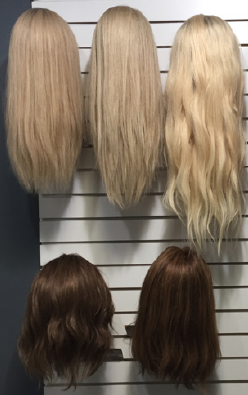
Human or Synthetic?
Many people mistakenly believe that you have to have a human-hair wig and spend a lot of money, or it will look bad. Or even worse, it will look like you are wearing a wig! That is simply not the case, and knowing what to look for will help you stretch your money with confidence.
Wigs can be made of human hair, synthetic fibers, or a combination of the two, commonly referred to as blends. For anyone experiencing the short-term hair loss associated with chemotherapy, a synthetic wig can be a low-maintenance, low-cost, and high-style option.
A human-hair wig, just like your own hair, needs to be restyled after it comes in contact with water. Human-hair wigs can be colored and styled with blow-dryers and curling irons. Such a wig requires some more care, but it will typically last up to 1 year with proper care.
A synthetic wig has a style that is locked in and will resume its shape after it is washed or gets wet. The color in a synthetic wig cannot be changed, but synthetic wigs come in a wide variety of colors. Unless otherwise labeled, a synthetic wig cannot withstand high heat from curling irons and blow-dryers. Synthetic wigs will need to be replaced after approximately 3 to 6 months of continued wear.
“Blends” can offer added realism of a human-hair wig with the ease of care of a synthetic wig. Blend wigs can tolerate heat in varying degrees. Always follow the manufacturer’s instructions.

5 Features That Add Believability
The features that add believability to a wig are:
- Length
- Thickness
- Texture
- Finish
- Color
Long wigs that fall below the shoulder can be heavy and are challenging to maintain, because they tangle easily. Knowing the possible issues that can arise will help you make a choice you are happy with.
Thick wigs can be hot and may contrast with thinning eyebrows and lashes that may shed during chemotherapy. A wig with waves, curls, or layers can give you the fuller look you seek, without the excess hair that can be less comfortable.
Texture in the hair adds believability. Straight hair exposes the part and hairline, 2 areas to conceal to keep believability high. If you truly want straight hair, add some layers to break up the look from the crown of the wig.
The finish on a wig can contribute to its believability. The matte and natural-looking finishes are more realistic than excessively shiny wigs.
Color is where more is better. When looking at wig colors, make sure you choose a color that has additional shades. This will add dimension, and with that, believability. The most common-looking wig would have highlights and lowlights. Some wigs are made with a darker color at the root, much like your own hair when the color is growing out. This is referred to as a rooted color and can help you pull off a color that is lighter than your own, while offering the believability of your natural hair at the base.
Key Points
- Synthetic wigs need to be replaced after 3 to 6 months of continued wear
- A human-hair wig lasts about 1 year
- A synthetic wig will resume its shape after it gets wet; a human-hair wig has to be restyled
- Wigs with matte or natural-looking finishes are more realistic than shiny wigs
- You may be able to submit a wig prescription from your doctor to your insurance company
5 Shopping Tips
- Be patient. A first-time shopping for a wig can create some anxiety, so taking a friend may help. Allow some time. Buying a wig is likely new to you, so spend some time looking at several options and visiting more than one store to be sure you select the best possible wig for your activity level, budget, and needs.
- Choose colors that are flattering. Especially for a first-time wig shopper, it can be very disorienting to try on a wig in a harsh or unflattering color. Most wigs are available in a variety of colors so if you see a style you like, ask to see it in a color that will look good before you try it.
- Little or no makeup. Wear as little foundation makeup as possible when trying to find a wig. The reason is that when you are receiving treatment for cancer, there may be times when you don’t want to wear makeup. If the color of the wig looks good without makeup, then you can have days when you wear your wig and little else, knowing that you still look good. Another reason is that you want to see the wig and your skin in natural daylight to choose accurately the right color for you. Treatment will likely result in changes to your skin, in addition to the hair loss, so seeing a wig color that flatters you can help you feel more confident.
- Glasses. If you wear glasses, try taking them off and then put them back on to see if the wig allows you to do this with little to no adjustments. If you don’t wear glasses, try this with sunglasses. The point is to see how your normal activities fare while wearing the wig to increase your confidence with the style you choose.
- Review all angles. Look at the wig from all angles. Using a handheld mirror, take a look at the front, back, and both sides of the wig. With the wig on, get up and walk toward a full-length mirror. This can be helpful to get the full effect of the look of the wig in proportion to you.
Health Insurance Tips
If you are receiving treatment for cancer, ask your oncologist to write you a prescription for a “cranial prosthetic.” That is the medical term for a wig. You may submit the prescription to your insurance company for reimbursement. If your insurance declines to pay, ask your doctor for a letter of medical necessity and resubmit.
Don’t hesitate to ask your oncologist or nurse navigator for assistance; this is a standard procedure that is required by many insurance companies. If your health insurance doesn’t cover cranial prosthetics, keep your receipt; you may be able to write it off as a medical tax deduction.
Hair Regrowth
Hair loss, regardless of its cause, is an unwelcome event. The information here will help to ease your journey. The rate of hair regrowth is about a half-inch per month, depending on your age and diet, among other factors.
People often notice enough coverage from their new hair to stop wearing a wig after 6 to 8 months. Some people like the convenience of a wig and continue to wear it until a desired length has been reached.
















